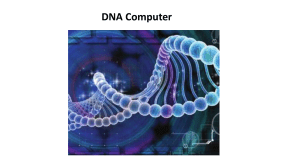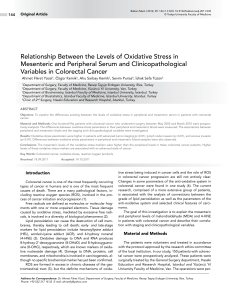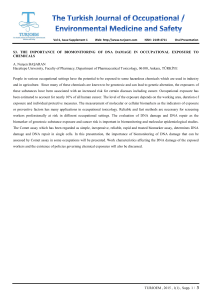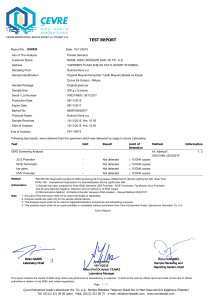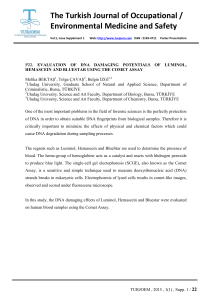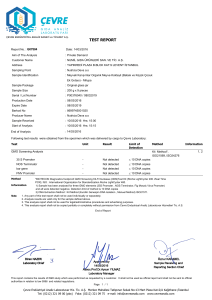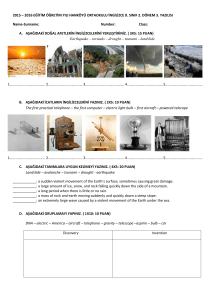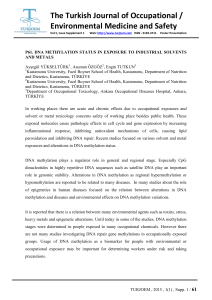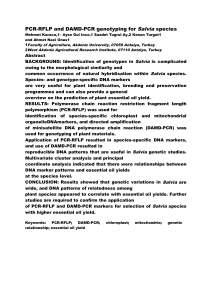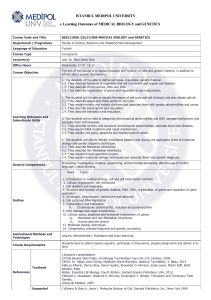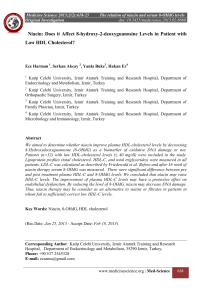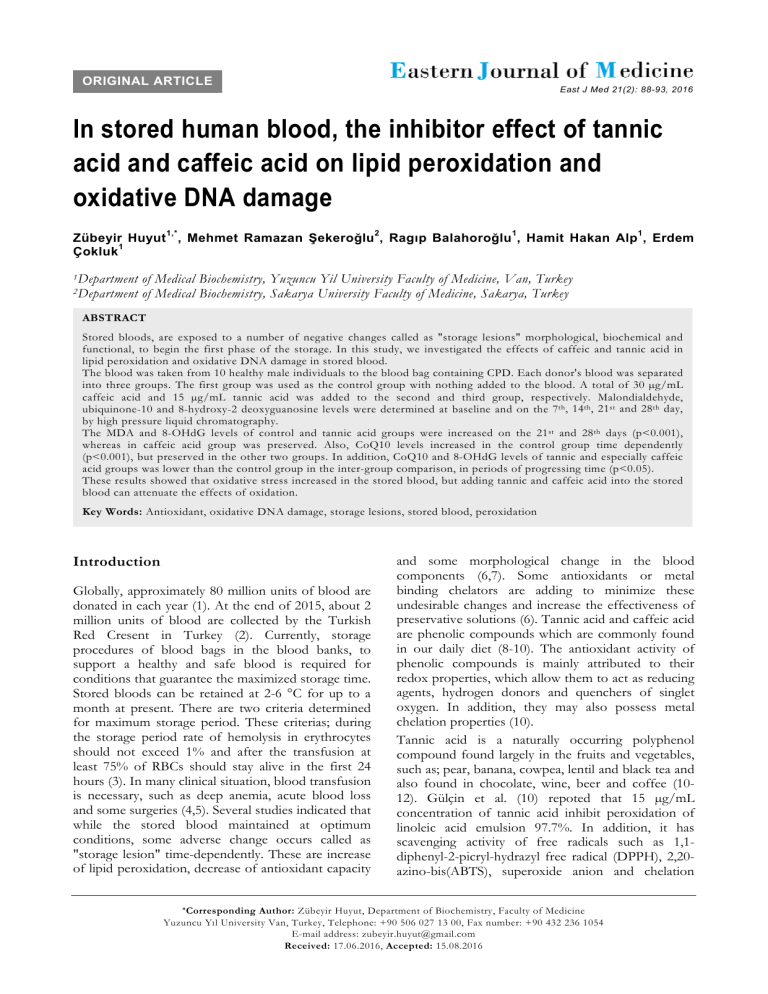
ORIGINAL ARTICLE
East J Med 21(2): 88-93, 2016
In stored human blood, the inhibitor effect of tannic
acid and caffeic acid on lipid peroxidation and
oxidative DNA damage
Zübeyir Huyut 1,* , Mehmet Ramazan Şekeroğlu2, Ragıp Balahoroğlu1, Hamit Hakan Alp 1, Erdem
Çokluk 1
1 Department
2 Department
of Medical Biochemistry, Yuzuncu Yil University Faculty of Medicine, Van, Turkey
of Medical Biochemistry, Sakarya University Faculty of Medicine, Sakarya, Turkey
ABSTRACT
Stored bloods, are exposed to a number of negative changes called as "storage lesions" morphological, biochemical and
functional, to begin the first phase of the storage. In this study, we investigated the effects of caffeic and tannic acid in
lipid peroxidation and oxidative DNA damage in stored blood.
The blood was taken from 10 healthy male individuals to the blood bag containing CPD. Each donor's blood was separated
into three groups. The first group was used as the control group with nothing added to the blood. A total of 30 µg/mL
caffeic acid and 15 µg/mL tannic acid was added to the second and third group, respectively. Malondialdehyde,
ubiquinone-10 and 8-hydroxy-2 deoxyguanosine levels were determined at baseline and on the 7th , 14 th , 21 st and 28 th day,
by high pressure liquid chromatography.
The MDA and 8-OHdG levels of control and tannic acid groups were increased on the 21 st and 28 th days (p<0.001),
whereas in caffeic acid group was preserved. Also, CoQ10 levels increased in the control group time dependently
(p<0.001), but preserved in the other two groups. In addition, CoQ10 and 8-OHdG levels of tannic and especially caffeic
acid groups was lower than the control group in the inter-group comparison, in periods of progressing time (p<0.05).
These results showed that oxidative stress increased in the stored blood, but adding tannic and caffeic acid into the stored
blood can attenuate the effects of oxidation.
Key Words: Antioxidant, oxidative DNA damage, storage lesions, stored blood, peroxidation
Introduction
Globally, approximately 80 million units of blood are
donated in each year (1). At the end of 2015, about 2
million units of blood are collected by the Turkish
Red Cresent in Turkey (2). Currently, storage
procedures of blood bags in the blood banks, to
support a healthy and safe blood is required for
conditions that guarantee the maximized storage time.
Stored bloods can be retained at 2-6 °C for up to a
month at present. There are two criteria determined
for maximum storage period. These criterias; during
the storage period rate of hemolysis in erythrocytes
should not exceed 1% and after the transfusion at
least 75% of RBCs should stay alive in the first 24
hours (3). In many clinical situation, blood transfusion
is necessary, such as deep anemia, acute blood loss
and some surgeries (4,5). Several studies indicated that
while the stored blood maintained at optimum
conditions, some adverse change occurs called as
"storage lesion" time-dependently. These are increase
of lipid peroxidation, decrease of antioxidant capacity
and some morphological change in the blood
components (6,7). Some antioxidants or metal
binding chelators are adding to minimize these
undesirable changes and increase the effectiveness of
preservative solutions (6). Tannic acid and caffeic acid
are phenolic compounds which are commonly found
in our daily diet (8-10). The antioxidant activity of
phenolic compounds is mainly attributed to their
redox properties, which allow them to act as reducing
agents, hydrogen donors and quenchers of singlet
oxygen. In addition, they may also possess metal
chelation properties (10).
Tannic acid is a naturally occurring polyphenol
compound found largely in the fruits and vegetables,
such as; pear, banana, cowpea, lentil and black tea and
also found in chocolate, wine, beer and coffee (1012). Gülçin et al. (10) repoted that 15 µg/mL
concentration of tannic acid inhibit peroxidation of
linoleic acid emulsion 97.7%. In addition, it has
scavenging activity of free radicals such as 1,1diphenyl-2-picryl-hydrazyl free radical (DPPH), 2,20azino-bis(ABTS), superoxide anion and chelation
* Corresponding Author: Zübeyir Huyut, Department of Biochemistry, Faculty of Medicine
Yuzuncu Yıl University Van, Turkey, Telephone: +90 506 027 13 00, Fax number: +90 432 236 1054
E-mail address: [email protected]
Received: 17.06.2016, Accepted: 15.08.2016
Huyut et al / The effect of tannic acid and caffeic acid on oxidative stress in stored blood
(8-OHdG) measurement at the beginning (day 0)
and on days 7, 14, 21, 28 by high pressure liquid
chromatography (HPLC).
Plasma MDA measurements by High Pressure
Liquid Chromatography (HPLC): MDA
measurement in plasma was performed according
to the method of Khoschsor et al. (14). Plasma
MDA measurements by High Pressure Liquid
Chromatography (HPLC): A total of 0.44 mol/L
H3PO4 and 42 mmol/L thiobarbituric acid (TBA)
was added to 50 μL plasma and incubated for 60
minutes in boiling water. After rapid cooling with
icy water, an equal volume of alkaline methanol
was added to the samples. After centrifugation at
3000 rpm for 3 minutes, the supernatant was
collected. RP-C18 (5μm, 4.6x150 mm, Eclipse
VDB-C18 Agilent) columns were used. For
elution, the mobile phase volume was prepared as
a 40:60 ratio with methanol and 50 mmol/L
phosphate buffer. The flow rate was adjusted to
0.8 mL/minute a total of 20 μL supernatant was
loaded onto the device and measured at 527 nm
excitation and 551 nm emission wavelength by
HPLC using a fluorescent detector (FLD). MDATBA product peaks were calibrated with 1,1,3,3Tetraethoxypropane standard solution. The
obtained results are expressed as μM.
Oxide CoQ10 Analysis: Oxidized CoQ10
analysis was performed according to the method
by Littarru et al. (15) The reductive CoQ10 was
forced to oxidize in plasma samples treated with
para-benzoquinone following extraction with 1propanol directly injected into the HPLC device.
For HPLC analysis, a reverse-phase ODS
supercoil C-18 (15x0.46 cm i.d. 3 µm) column was
used. For analysis, 50 µL 1,4-benzoquinone (2
mg/mL) was added to 200 µL plasma and mixture
was vortexed. After 10 minutes incubation at
room temperature, 1 mL n-propanol was added,
and the mixture was vortexed during 10 sec. It
was centrifuged at 600 g for 2 minutes. A total of
200 µL was collected from the supernatant, put
into a vial and loaded onto the HPLC device. For
spectral analysis, the UV detector was adjusted to
275 nm, and the ethanol-methanol (65-35% v/v)
mobile phase flow rate was adjusted to 1
mL/minute. The system was stabilized after
balancing the column, and oxidized CoQ10 was
measured by the electrochemical detector adjusted
to 0.35 V. The obtained results are expressed as
µM.
Isolation and Hydrolysis of DNA: DNA was
isolated from whole blood leukocytes by DNA
isolation kit (Vivantis GF-1 blood DNA
extraction kit, Vivantis Technologies SDN. BHD,
capacity of ferrous ions (Fe2+), hydrogen peroxide
scavenging.
Caffeic acid and its derivatives are good substrates of
polyphenol oxidases, and under certain condition may
undergo oxidation. It has been reported that Caffeic
acid (3,4-dihydroxycynnamic acid) act as the
protective of α-Tocopherol in low density
lipoproteins (13). Gülçin (9) has reported that caffeic
acid inhibited peroxidation of linoleic acid emulsion
in samples 75.8% added 30 µg/mL caffeic acid. In
addition, caffeic acid is an effective ABTS scavenging,
DPPH scavenging, superoxide anion radical
scavenging, total reducing power and metal chelating
on ferrous ions activities (9). Also, the most
antioxidant effect of caffeic and tannic acid is at 30
and 15 µg/mL concentrations as in vitro, respectively
(9,10).
There is no literature on the antioxidant effects of
caffeic and tannic acid in stored blood. In this study
we investigated the effects of caffeic and tannic acid
on lipid peroxidation, mitochondrial membrane
damage and oxidative DNA damage in the stored
blood.
Materials and Methods
The study protocol was carried out in accordance
with Helsinki decleration as revised in 2000. The
study was also approved by Ethics Committee of
the Clinical Drug Applications, Faculty of
Medicine, Yuzuncu Yil University (date:
13.08.2014 and number of decision: 05) and all
patients gave informed consent.
Blood Sampling: Blood was collected into
quaternary pediatric pouch systems (Kansuk®,
Turkey) containing citrate-phosphate-dextrose
(CPD) from 10 healthy volunteers. Blood pouches
contained 500 mL blood and each of 70 mL CPD
(0,299 citric acid anhydrate, 2.63 g sodium citrate
dihydrate, 0.222 g sodium dihydrogen phosphate
monohydrate and 2.55 g dextrose monohydrate).
Each 500 mL bag was transferred into three 150
mL pediatric bags. One of the bags was used as
control, while the others were added with either
tannic acid (15 µg/mL) or caffeic acid (30 µg/mL)
and denoted as tannic acid and caffeic acid
groups. The bloods were then stored at +4 °C.
Before taking samples the bags were gently turned
upside down to homogenize the stored blood. Six
milliliters of blood was taken from each bag and
four milliliters centrifuged (1100 rpm) and the
plasma was obteined to measure plasma
malondialdehyde (MDA), ubiquinone-10 (CoQ10)
levels and two milliliters of whole blood was
separated for DNA 8-hydroxy-2 deoxyguanosine
East J Med Volume:21, Number:2, April-June/2016
89
Huyut et al / The effect of tannic acid and caffeic acid on oxidative stress in stored blood
multiple range test was performed to identify
different groups and Friedman analysis was
performed to assess for significant differences
on a continuous dependent variable in
measuring periods. Statistical analysis was
performed using the SPSS 15 statistics package
program (SPSS Inc., IL, USA).
Malaysia) with the spin column method. 200 µL
blood sample was placed in the microcentrifuge
tube and solutions were added according to the kit
prospectus solution, respectively. As a result of
isolation carried out in accordance to the kit
prospectus, final volume was 100 µL. DNA
aliquots were thawed for 8-OHdG analysis and
hydrolysed as previously described by Kaur and
Halliwell (1996) (16). Hydrolysed DNA samples
were dissolved in HPLC elution buffer (final
volume, 1 mL). 8-OHdG levels were measued by
HPLC using EC detector. A total of 20 µL final
hydrolysate was measured by HPLC using ECD.
Reverse-phase-C-18 (RP-C18) analytical columns
(250 mm × 4.6 mm × 4.0 μm, Phenomenex, CA)
were used. The mobile phase was 0.05 M
potassium phosphate buffer (pH 5.5) and
acetonitrile mixture (97:3, v/v), and the flow rate
was adjusted to 1 mL/min. The levels of 8-OHdG
were measured by HPLC with the ECD adjusted
to 600 mV. The obtained sample peaks were
calibrated with the 8-OHdG standard purchased
from Sigma Aldrich Company (Sigma diagnostics,
St. Louis, MO, USA). The 8-OHdG values were
expressed as µM (17).
Statistical Analysis: Results are represented as
Mean ± Standard Error of Mean (SE). Values
between the groups were analyzed by two-way
ANOVA. Following variance analysis, the Duncan
Results
The MDA levels of control group and tannic acid
groups were significantly higher on 21st and 28th
day than baseline (p<0.001). However, there was
no significant difference in the caffeic acid group
(Table 1).
Oxidized CoQ10 which is an indicator of
mitochondria membrane damage levels, were not
changed in tannic and caffeic acid groups, whereas
increased in the control group (p<0.001), on the
21st and 28th days (Table 2). The oxidized CoQ10
level of tannic and caffeic acid groups was
significantly decreased in stored blood on the 21st
and 28th days compared to the baseline in the
control group (p<0.001). In addition, oxidized
CoQ10 level of caffeic acid group was significantly
lower compared to the control and tannic acid
groups on the 14th and 28th days (p<0.001).
Table 1. The effect of tannic acid and caffeic acid on MDA levels in stored blood
MDA (µM)
Days
Baseline
7th day
14th day
21st day
28th day
Control (Mean±SE)
1.209 ± 0.345
1.381 ± 0.168
1.381 ± 0.271
1.711 ± 0.370*
1.849 ± 0.289*
Tannic Acid (Mean±SE)
1.219 ± 0.257
1.250 ± 0.286
1.479 ± 0.171
1.610 ± 0.281*
1.763 ± 0.346*
Caffeic Acid (Mean±SE)
1.217 ± 0.208
1.282 ± 0.280
1.331 ± 0.222
1.400 ± 0.336
1.444 ± 0.335
"*" Compared to baseline in intragroup (p<0.001)
Table 2. The effects of tannic and caffeic acid on the level of oxidized CoQ10.
CoQ10 (µM)
Days
Control (Mean±SE)
Tannic Acid (Mean±SE)
1.947 ± 0.533
1.888 ± 0.282
Baseline
2.037 ± 0.416
2.043 ± 0.318**
7th day
th
1.955 ± 0.368
1.729 ± 0.460
14 day
st
2.306 ± 0.243*
1.889 ± 0.277**
21 day
2.577 ± 0.259*
2.190 ± 0.353**
28th day
"*" Compared to baseline in intragroup (p<0.001)
"**" Compared to the control group (p<0.001)
"҂" Compared to the control and tannic acid groups (p<0.001)
East J Med Volume:21, Number:2, April-June/2016
90
Caffeic Acid (Mean±SE)
1.934 ± 0.361
1.936 ± 0.534**
1.814 ± 0.132*,҂
1.840 ± 0.327**
1.997 ± 0.428**,҂
Huyut et al / The effect of tannic acid and caffeic acid on oxidative stress in stored blood
Discussion
The levels of 8-OhdG, is an indicator of oxidative
DNA damage, assessed according to the time,
levels of 8-OHdG was increased in the control
and tannic acid groups on the 21st and 28th days
(p<0.001). On the other hand, no significant
change was determined in caffeic acid group
(p>0.05, Table 3). Furthermore, 8-OHdG levels
of tannic and caffeic acid groups were significantly
lower than control group on the 28th day in the
intergroup comparisons (p<0.002).
The comparison of MDA, CoQ10 and 8-OhdG
levels changed between baseline and 28th days and
between groups showed in Figure 1. MDA,
CoQ10 and 8-OHdG levels of caffeic acid group
were lower than control group on 28th day,
percentage of 64.5%, 99.5%, 78% respectively and
also decreased in tannic acid group percentage of
58%, 99%, 31% respectively. In the tannic acid
group, CoQ10 and 8-OHdG levels were less than
control group, percentage of 52% and 68.5%,
respectively (p<0.05) whereas MDA levels did not
change significantly.
The development of blood storage system is of
great importance owing to the increasing demand
of stored blood due to natural calamities and
emergencies. Availability of storage raises the
question of how long blood products can and
should be stored, and how long they are safe and
effective (18). During the storage period, it is
known that the increase of oxidative stress caused
by the formation of reactive oxygen species such
as; hydroxyl radical, H2 O2 and superoxide anion
radical (19). Free radicals can lead to irreversible
damage to the protein and lipids that are found in
structure of cell membranes. Thus, membrane
integrity is impaired and cell becomes suitable to
penetration (20). Plasma is an important
component of whole blood and it reflects the
changes occurring in whole blood. In plasma most
of the cholesterol is esterified. Esterified
cholesterol can be converted to unstable lipid
hydroperoxides. Lipid peroxidation continues up
Table 3. The effects of tannic and caffeic acid on the level of 8-OHdG
Days
Baseline
7th day
14th day
21st day
28th day
Control (Mean±SE)
1.617 ± 0.242
1.640 ± 0.334
1.802 ± 0.254
2.395 ± 0.446*
4.540 ± 0.303*
8-OHdG (µM)
Tannic Acid (Mean±SE)
1.599 ± 0.328
1.799 ± 0.340
1.890 ± 0.362
2.215 ± 0.317*
2.517 ± 0.424*,**
Caffeic Acid (Mean±SE)
1.578 ± 0.266
1.695 ± 0.235
1.913 ± 0.437
1.982 ± 0.233
2.213 ± 0.278**
"*" Compared to baseline in intragroup (p<0.001)
"**" Compared to the control group (p<0.002)
Fig. 1. Comparison of change between inter groups on baseline and 28th day.
"*" Compared to the control group (p<0.05)
"҂" Compared to the tannic acid group (p<0.05)
East J Med Volume:21, Number:2, April-June/2016
91
Huyut et al / The effect of tannic acid and caffeic acid on oxidative stress in stored blood
damage. Tannic and caffeic acid have effective
superoxide anion radical scavenging, total
reducing power and metal chelating on ferrous
ions activities, these might explain those results.
As a result this study showed that, oxidative stress
and lipid peroxidation increased time-dependently
in stored blood. Adding tannic acid and caffeic
acid into the stored blood protected stored bood
against oxidative DNA damage and increased lipid
peroxidation especially last period of storage time.
In addition, these results also showed that, adding
tannic acid and caffeic acid into the stored blood
may be retarding the formation of toxic oxidation
products, and prolonging the lifespan of stored
blood components.
Conflict of Interest: None declared
Sources for Funding: No funding was obtained
for the preparation of this manuscript.
to the formation of MDA which can modify the
proteins and together with membrane lipids, cause
membrane damage. Protecting activity of
antioxidant defense system may preserve MDA at
low level (20-22).
Studies in stored whole blood components play an
important role to understand the alteration of
oxidative stress during storage (23). Şekeroğlu et.
al. (6) reported that MDA levels of erythrocytes
increased time-dependently in their study. In the
current study we also found that erythrocyte MDA
levels increased with storage time in the stored
blood. In spite that, adding caffeic acid into the
stored blood preserved MDA in low levels
compared to the other groups.
Ubiquinol-10
(CoQ10H)
a
lipid-soluble
component of virtually all cell membranes, is an
essential electron carrier in the mitochondrial
respiratory chain and an important antioxidant in
the mitochondrial inner membrane (24). There are
two major forms of CoQ10; reduced ubiquinol
(CoQ10H) and oxidized (CoQ10). The high rate
of CoQ10/CoQ10H or high level of oxidized
CoQ10 is an important indicator in determining
mitochondrial membrane damage (25,26). Until
now, there are no studies that show the
mitochondrial membrane damage in stored blood.
In this study the levels of oxidized CoQ10 were
increased in the control group time dependently.
However, CoQ10 levels of tannic and caffeic acid
groups were preserved. These positive results may
be caused by the free radicals scavenging activities
of tannic and caffeic acid in stored blood.
Reactive oxygen species (ROS) are formed
continuously as a consequence of biochemical
reactions. ROS can attack any cellular structure or
molecule so DNA is considered as an important
target. Thus, ROS may cause DNA-protein crosslinks and sugar moiety damage as well as specific
chemical modifications of the purine and
pyrimidine bases. One of the most abundant
oxidative damages to DNA bases is the 8hydroxylation of guanine (27). 8OHdG is one of
the available biomarkers for oxidative DNA
damage (28). We could not find any literature that
shows oxidative DNA damage in the stored blood.
The current study explored the protective effect
of caffeic acid against oxidative DNA damage in
stored blood and found that in storage with
caffeic acid 8OHdG levels were significantly
preserved.
However, the increase in 8-OHdG level was less
in the tannic acid group compared to the control
group, indicating that tannic acid has partially
protective effect against in vitro oxidative DNA
References
1.
2.
3.
4.
5.
6.
7.
8.
9.
Lei C, Xiong LZ. Perioperative Red Blood Cell
Transfusion: What We Do Not Know. Chin Med J
(Engl) 2015; 128: 2383-2386.
Kan
bağışında
2015
yılı
başarısı.
http://www.kizilay.org.tr/Haber/HaberArsivi
Detay/ 2477; in Turkish.
Mustafa I, Al Marwani A, Mamdouh Nasr K,
Abdulla Kano N, Hadwan T. Time Dependent
Assessment
of
Morphological
Changes:
Leukodepleted Packed Red Blood Cells Stored in
SAGM. Biomed Res Int 2016; 2016: 4529434.
Beutler, E. Preservation and clinical use of
erythrocytes and whole blood. In Williams
Hematology, Editors; Marshall A. Lichtman,
Ernest Betler, Thomas J. Kipps,Uri Selighsohn,
Kenneth Kaushansky, Josef T. Prchal. The Mc
Graw-Hill Companies 2006; 2159-2163.
Huyut Z, Şekeroğlu MR, Balahoroğlu R,
Karakoyun T, Çokluk E. The relationship of
oxidation sensitivitiy of red blood cells and
carbonic anhydrase activity in stored human
blood: Effects of certain phenolic compounds.
Bio Med Res Int 2016; Article ID 3057384.
Şekeroğlu MR, Huyut Z, Him A. The
susceptibility of erythrocytes to oxidation during
storage of blood: Effect of melatonin and
propofol. Clin Biochem 2012; 45: 315-319.
Aslan R, Şekeroğlu MR, Tarakçıoğlu M, Köylü H.
Investigation of Malondialdehyde formation and
antioxidant enzyme activity in stored blood.
Haematol 1997; 28: 233-237.
Gülçin İ. Antioxidant properties of resveratrol: a
structureactivity insight. Innov Food Sci Emerg
2010; 11: 210-218.
Gülçin İ. Antioxidant activity of caffeic acid (3,
4-dihydroxycinnamic acid). Toxicology 2006; 217:
213-220.
East J Med Volume:21, Number:2, April-June/2016
92
Huyut et al / The effect of tannic acid and caffeic acid on oxidative stress in stored blood
10. Gülçin İ, Huyut Z, Elmastaş M, Y. Aboul-Enein
H. Radical scavenging and antioxidant activity of
tannic acid. Arab J Chem, King Saud University
2010; 3: 43-53.
11. Chung KT, Wong TY, Wei CI, Huang YW, Lin
Y. Tannins and human health: a review. Crit Rev
Food Sci 1998; 38: 421.
12. King A, Young G. Characteristics and occurrence
of phenolic phytochemicals. J Am Diet Assoc
1999; 99: 213.
13. Laranjinha J, Vieira O, Madeira V, Almeida L.
Two related phenolic antioxidants with opposite
effects on vitamin E content in low density
lipoproteins
oxidized
by
ferrylmyoglobin:
consumption vs. regeneration. Arch Biochem
Biophys 1995; 323: 373-381.
14. Khoschsorur GA, Winklhofer-Roob BM, RabP
H, et al. Evaluation of a Sensitive HPLC Method
for the Determination of Malondialdehyde and
Application of the Method to Different
Biological Materials. Chromatographia 2000; 52:
181-184.
15. Littarru GP, Mosca F, Fattorini D, Bompadre S,
Battino M. Assay of coenzyme Q10 in plasma by
a single dilution step. Method Enzymol 2004;
378: 170-176.
16. Kaur H, Halliwell B. Measurement of oxidized
and methylated DNA bases by HPLC with
electrochemical detection. Biochem J 1996; 318:
21-23.
17. Tarng DG, Huang TP, Wei YH, et al. 8-hydroxy2 -deoxyguanosine of leukocyte DNA as a marker
of oxidative stress in chronic hemodialysis
patients. Am J Kidney Dis 2000; 36: 934-944.
18. Hess JR, Greenwalt TG. Storage of red blood
cells: new approaches. Transfus Med Rev 2002;
16: 283-295.
19. Vani R, Reddy CS, Devi AS. Oxidative stress in
erythrocytes: a study on the effect of antioxidant
20.
21.
22.
23.
24.
25.
26.
27.
28.
mixtures during intermittent exposures to high
altitude. Int J Biometeorol 2010; 57: 1024-1037.
Marjani A, Marodi A, Ghourcaie AB. Alterations
in plasma lipid peroxidation and erythrocyte
superoxide dismutase and glutathione peroxidase
dismutase Enzyme activities during storage of
blood. Asian J Biochem 2007; 2: 118-123.
Rajashekharaiah V, Abraham Koshy A, Kumar
Koushik A, et al. The efficacy of erythrocytes
isolated from blood stored under blood bank
conditions, Transfus Apher Sci 2012; 47: 359-364.
John S, Kale M, Rathore N, Bhatnagar D.
Protective effect of vitamin E in dimethoate and
malathion induced oxidative stress in rat
erythrocytes. J Nutr Biochem 2001; 12: 500-504.
Hsieh C, Ahuja C, Kumari N, Sinha T,
Rajashekharaiah V. Curcumin as a modulator of
oxidative stress during storage: A study on
plasma. Transfus Apher Sci 2014; 50: 288-293.
Ostman B, Sjodin A, Michaelsson K, Byberg L.
Coenzyme Q10 supplementation and exerciseinduced oxidative stress in humans. Nutrition
2012; 28: 403-417.
Stocker R, Bowry VW, Frei B. Ubiquinol-10
Protects Human Low-Density-Lipoprotein More
Efficiently against Lipid-Peroxidation Than Does
Alpha-Tocopherol. P Natl Acad Sci USA 1991;
88: 1646-1650.
Yamashita S, Yamamoto Y. Simultaneous
detection of ubiquinol and ubiquinone in human
plasma as a marker of oxidative stress. Anal
Biochem 1997; 250: 66-73.
Loft S, Fischernielsen A, Jeding IB, Vistisen K,
Poulsen HE. 8-hydroxydeoxyguanosine as a
urinary biomarker of oxidative DNA-damage. J
Toxicol Env Health 1993; 40: 391-404.
Halliwell B GJ. Free Radicals in Biology and
Medicine. Oxford: Oxford Science Publications;
1999.
East J Med Volume:21, Number:2, April-June/2016
93

